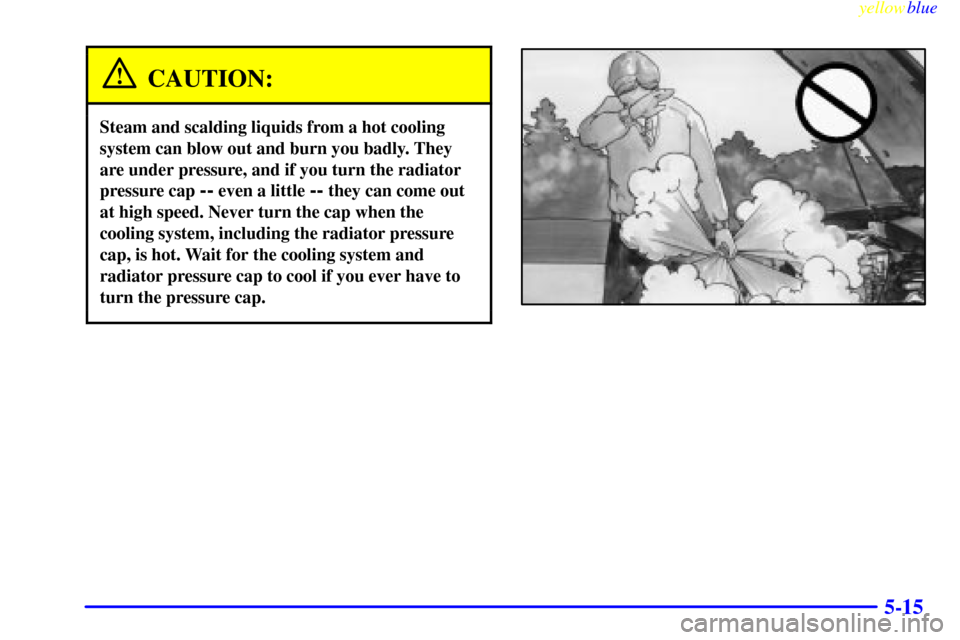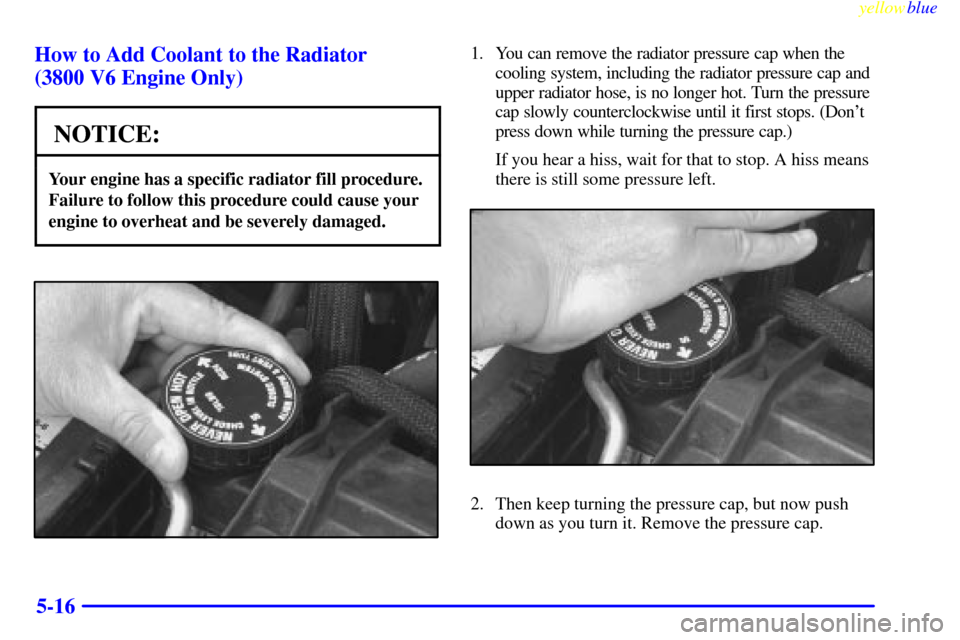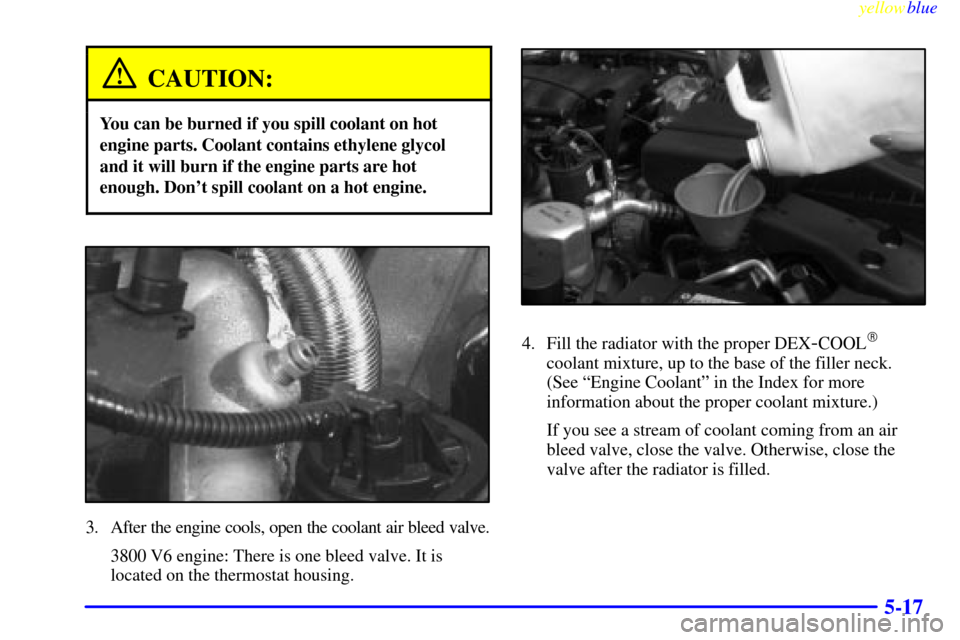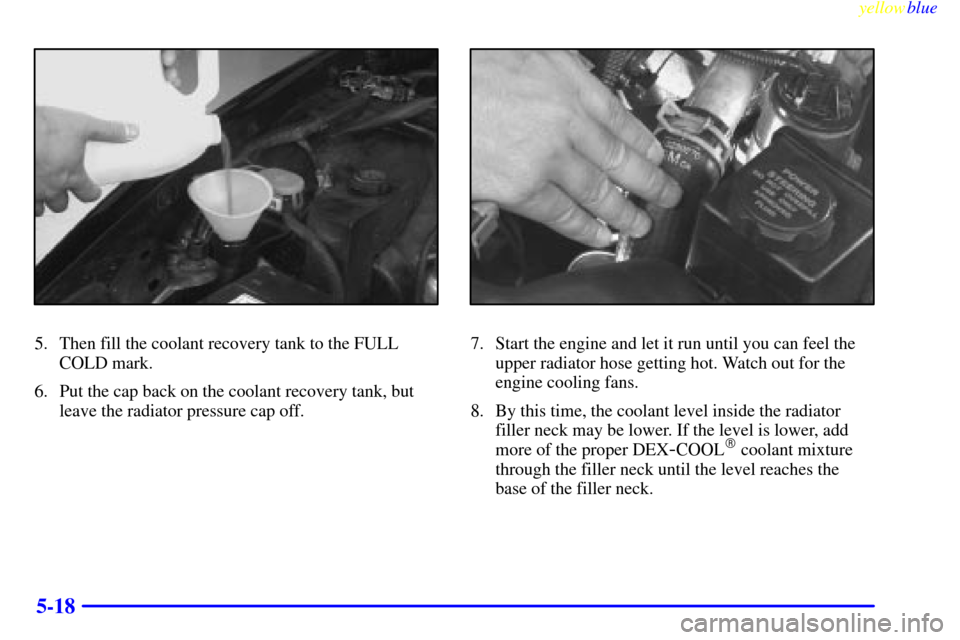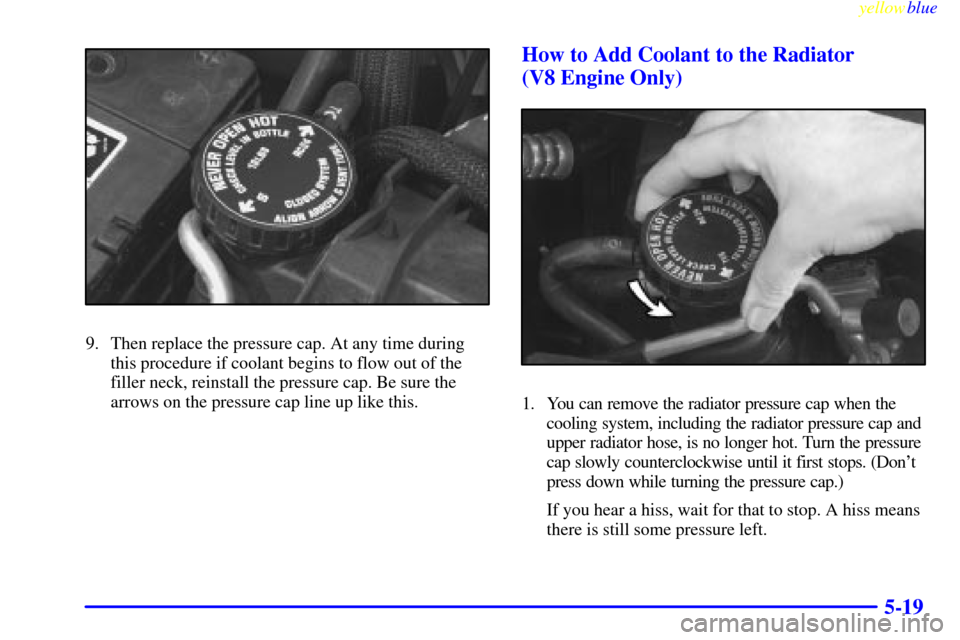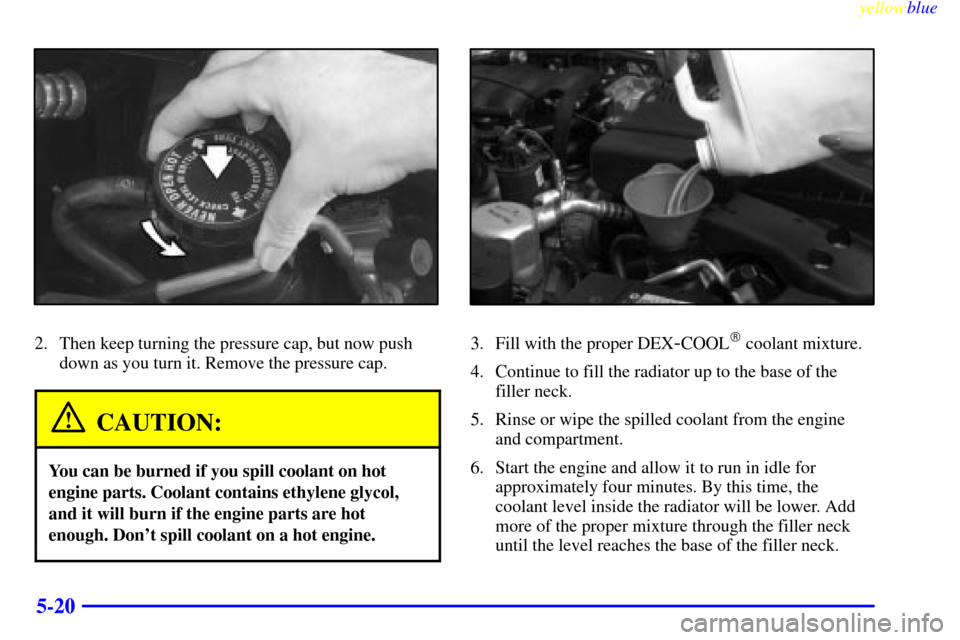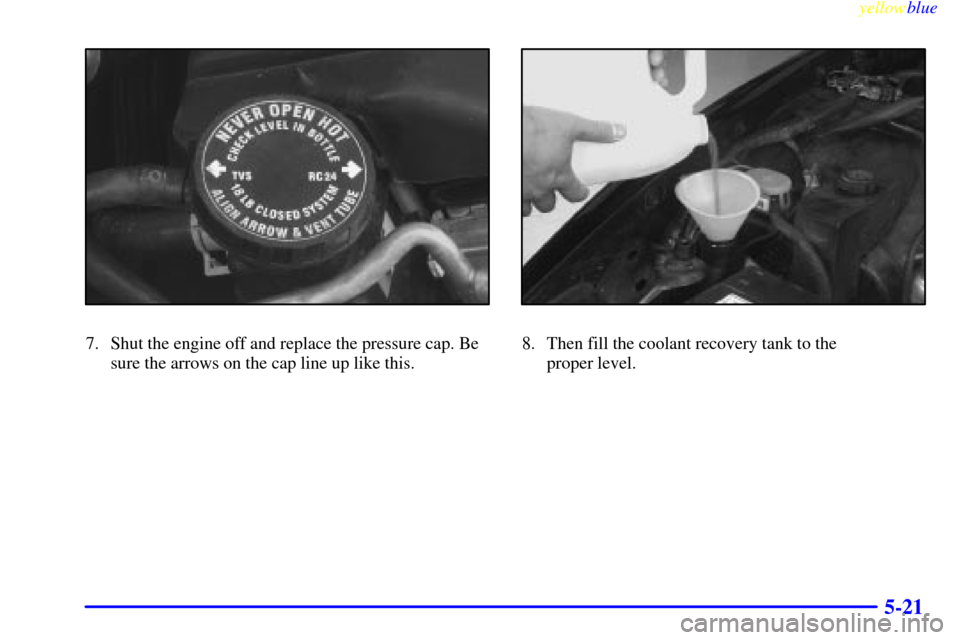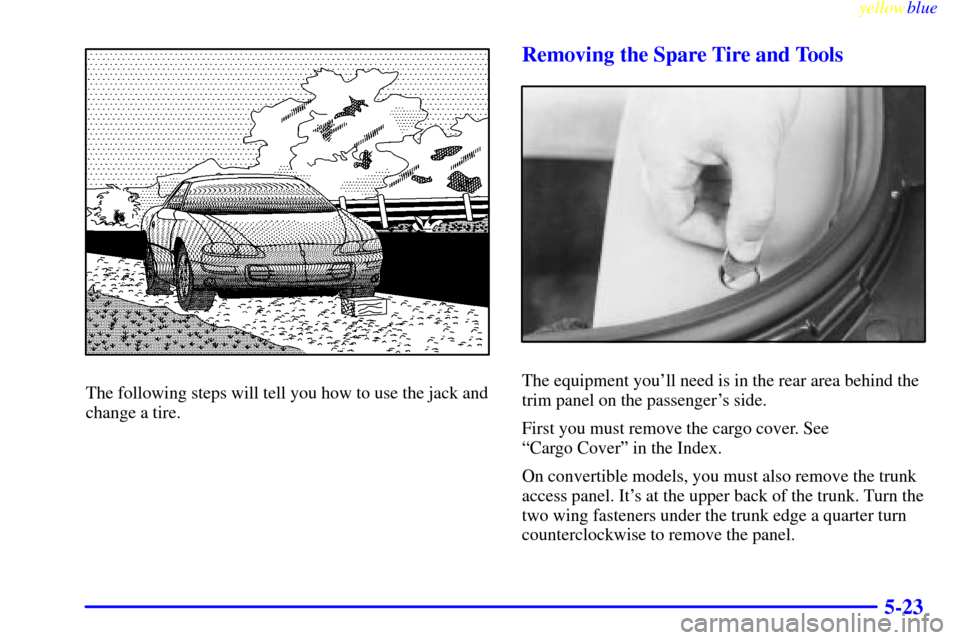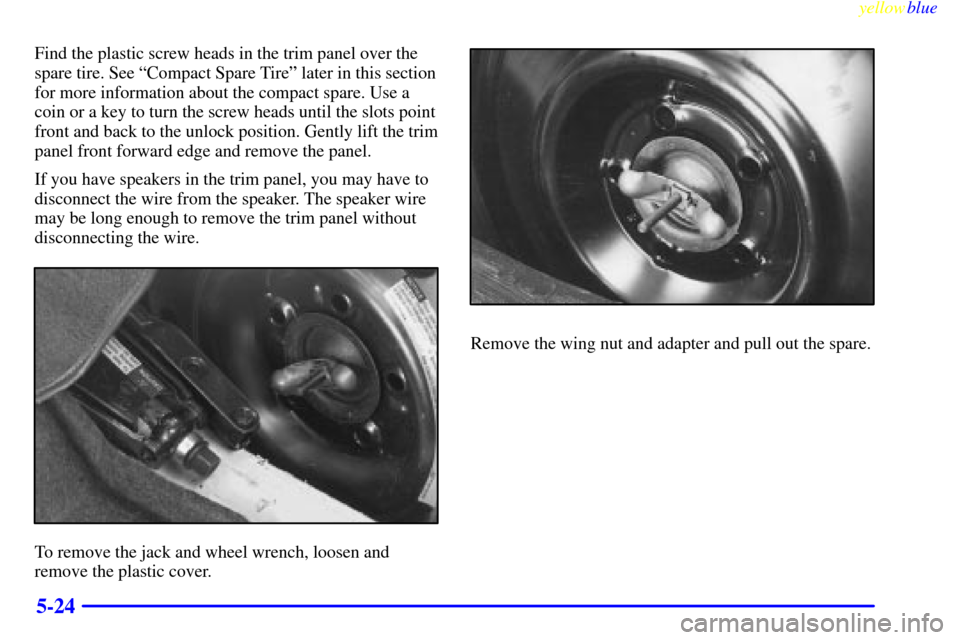CHEVROLET CAMARO 1999 4.G Owners Manual
CAMARO 1999 4.G
CHEVROLET
CHEVROLET
https://www.carmanualsonline.info/img/24/8056/w960_8056-0.png
CHEVROLET CAMARO 1999 4.G Owners Manual
Trending: climate control, dead battery, child seat, wipers, air conditioning, load capacity, fuse box
Page 231 of 376
yellowblue
5-15
CAUTION:
Steam and scalding liquids from a hot cooling
system can blow out and burn you badly. They
are under pressure, and if you turn the radiator
pressure cap
-- even a little -- they can come out
at high speed. Never turn the cap when the
cooling system, including the radiator pressure
cap, is hot. Wait for the cooling system and
radiator pressure cap to cool if you ever have to
turn the pressure cap.
Page 232 of 376
yellowblue
5-16 How to Add Coolant to the Radiator
(3800 V6 Engine Only)
NOTICE:
Your engine has a specific radiator fill procedure.
Failure to follow this procedure could cause your
engine to overheat and be severely damaged.
1. You can remove the radiator pressure cap when the
cooling system, including the radiator pressure cap and
upper radiator hose, is no longer hot. Turn the pressure
cap slowly counterclockwise until it first stops. (Don't
press down while turning the pressure cap.)
If you hear a hiss, wait for that to stop. A hiss means
there is still some pressure left.
2. Then keep turning the pressure cap, but now push
down as you turn it. Remove the pressure cap.
Page 233 of 376
yellowblue
5-17
CAUTION:
You can be burned if you spill coolant on hot
engine parts. Coolant contains ethylene glycol
and it will burn if the engine parts are hot
enough. Don't spill coolant on a hot engine.
3. After the engine cools, open the coolant air bleed valve.
3800 V6 engine: There is one bleed valve. It is
located on the thermostat housing.
4. Fill the radiator with the proper DEX-COOL�
coolant mixture, up to the base of the filler neck.
(See ªEngine Coolantº in the Index for more
information about the proper coolant mixture.)
If you see a stream of coolant coming from an air
bleed valve, close the valve. Otherwise, close the
valve after the radiator is filled.
Page 234 of 376
yellowblue
5-18
5. Then fill the coolant recovery tank to the FULL
COLD mark.
6. Put the cap back on the coolant recovery tank, but
leave the radiator pressure cap off.7. Start the engine and let it run until you can feel the
upper radiator hose getting hot. Watch out for the
engine cooling fans.
8. By this time, the coolant level inside the radiator
filler neck may be lower. If the level is lower, add
more of the proper DEX
-COOL� coolant mixture
through the filler neck until the level reaches the
base of the filler neck.
Page 235 of 376
yellowblue
5-19
9. Then replace the pressure cap. At any time during
this procedure if coolant begins to flow out of the
filler neck, reinstall the pressure cap. Be sure the
arrows on the pressure cap line up like this.
How to Add Coolant to the Radiator
(V8 Engine Only)
1. You can remove the radiator pressure cap when the
cooling system, including the radiator pressure cap and
upper radiator hose, is no longer hot. Turn the pressure
cap slowly counterclockwise until it first stops. (Don't
press down while turning the pressure cap.)
If you hear a hiss, wait for that to stop. A hiss means
there is still some pressure left.
Page 236 of 376
yellowblue
5-20
2. Then keep turning the pressure cap, but now push
down as you turn it. Remove the pressure cap.
CAUTION:
You can be burned if you spill coolant on hot
engine parts. Coolant contains ethylene glycol,
and it will burn if the engine parts are hot
enough. Don't spill coolant on a hot engine.
3. Fill with the proper DEX-COOL� coolant mixture.
4. Continue to fill the radiator up to the base of the
filler neck.
5. Rinse or wipe the spilled coolant from the engine
and compartment.
6. Start the engine and allow it to run in idle for
approximately four minutes. By this time, the
coolant level inside the radiator will be lower. Add
more of the proper mixture through the filler neck
until the level reaches the base of the filler neck.
Page 237 of 376
yellowblue
5-21
7. Shut the engine off and replace the pressure cap. Be
sure the arrows on the cap line up like this.8. Then fill the coolant recovery tank to the
proper level.
Page 238 of 376
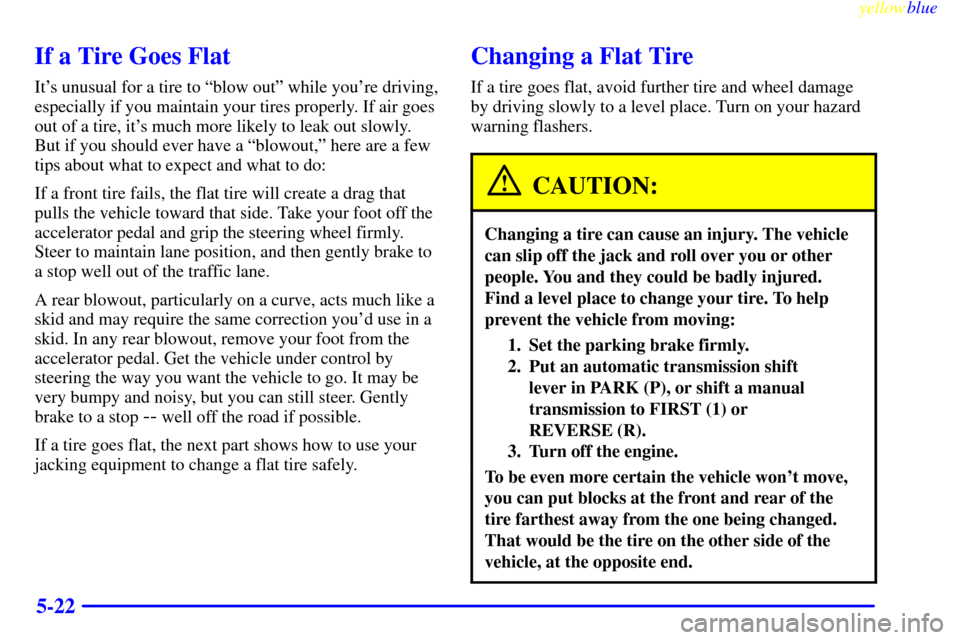
yellowblue
5-22
If a Tire Goes Flat
It's unusual for a tire to ªblow outº while you're driving,
especially if you maintain your tires properly. If air goes
out of a tire, it's much more likely to leak out slowly.
But if you should ever have a ªblowout,º here are a few
tips about what to expect and what to do:
If a front tire fails, the flat tire will create a drag that
pulls the vehicle toward that side. Take your foot off the
accelerator pedal and grip the steering wheel firmly.
Steer to maintain lane position, and then gently brake to
a stop well out of the traffic lane.
A rear blowout, particularly on a curve, acts much like a
skid and may require the same correction you'd use in a
skid. In any rear blowout, remove your foot from the
accelerator pedal. Get the vehicle under control by
steering the way you want the vehicle to go. It may be
very bumpy and noisy, but you can still steer. Gently
brake to a stop
-- well off the road if possible.
If a tire goes flat, the next part shows how to use your
jacking equipment to change a flat tire safely.
Changing a Flat Tire
If a tire goes flat, avoid further tire and wheel damage
by driving slowly to a level place. Turn on your hazard
warning flashers.
CAUTION:
Changing a tire can cause an injury. The vehicle
can slip off the jack and roll over you or other
people. You and they could be badly injured.
Find a level place to change your tire. To help
prevent the vehicle from moving:
1. Set the parking brake firmly.
2. Put an automatic transmission shift
lever in PARK (P), or shift a manual
transmission to FIRST (1) or
REVERSE (R).
3. Turn off the engine.
To be even more certain the vehicle won't move,
you can put blocks at the front and rear of the
tire farthest away from the one being changed.
That would be the tire on the other side of the
vehicle, at the opposite end.
Page 239 of 376
yellowblue
5-23
The following steps will tell you how to use the jack and
change a tire.
Removing the Spare Tire and Tools
The equipment you'll need is in the rear area behind the
trim panel on the passenger's side.
First you must remove the cargo cover. See
ªCargo Coverº in the Index.
On convertible models, you must also remove the trunk
access panel. It's at the upper back of the trunk. Turn the
two wing fasteners under the trunk edge a quarter turn
counterclockwise to remove the panel.
Page 240 of 376
yellowblue
5-24
Find the plastic screw heads in the trim panel over the
spare tire. See ªCompact Spare Tireº later in this section
for more information about the compact spare. Use a
coin or a key to turn the screw heads until the slots point
front and back to the unlock position. Gently lift the trim
panel front forward edge and remove the panel.
If you have speakers in the trim panel, you may have to
disconnect the wire from the speaker. The speaker wire
may be long enough to remove the trim panel without
disconnecting the wire.
To remove the jack and wheel wrench, loosen and
remove the plastic cover.
Remove the wing nut and adapter and pull out the spare.
Trending: trunk, power steering, maintenance, wheel size, trip computer, fuel tank capacity, belt
